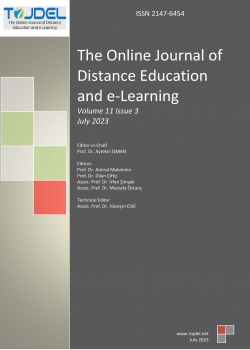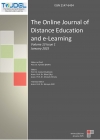TOJDEL - Volume 11 - Issue 3 - July 2023
 AN INVESTIGATION OF CORONA VIRUS PANDEMIC ON THE ONLINE EDUCATION: A STRUCTURAL MODELLING APPROACH
AN INVESTIGATION OF CORONA VIRUS PANDEMIC ON THE ONLINE EDUCATION: A STRUCTURAL MODELLING APPROACH Rakesh Singh, Saba Siddiqui, Dinesh Chand
Abstract:
This study aimed to find out the effect of Corona Virus Environment (CVE) with the Online Education-Study from Home (OESFH) and to know the mediating impact of Corona Virus Awareness (CVA) between Corona virus Environment and Online Education-Study from Home. The first hypothesis has been formulated as there is no significant effect of Corona Virus Environment on the Online Education-Study from Home whereas the second hypothesis formulated as Corona Virus Awareness does not significantly mediate the relationship between Corona Virus Environment and the Online Education-Study from Home. The mediating analysis has been done for the testing of hypotheses. The findings of this study conclude that there is an effect of Corona Virus Environment on the Online Education and Corona Virus Awareness significantly mediates the relationship between the Corona Virus Environment and the Online Education-Study from Home.
 ARTIFICIAL INTELLIGENCE AS PERCEIVED BY UNIVERSITY TEACHERS: AN ANALYSIS IN THE LIGHT OF DEMOGRAPHIC VARIABLES
ARTIFICIAL INTELLIGENCE AS PERCEIVED BY UNIVERSITY TEACHERS: AN ANALYSIS IN THE LIGHT OF DEMOGRAPHIC VARIABLES Venkateswar Meher, Nikita Yadav, Pradeep Kumar Tiwari, Rajkumari Singh
Abstract:
In the present study, we examined the perception of university teachers towards artificial intelligence in the light of demographic variables like gender, locality, age, teaching experience, and academic streams. We selected approximately 101 teachers from IFTM University, Moradabad as the sample for the study. We collected primary data on teachers’ perceptions through online mode using google forms. The descriptive result revealed a mixed perception of university teachers about artificial intelligence. There was a significant effect of gender and age on the perception of teachers towards AI, which revealed that the perception of male teachers was higher towards artificial than females. Further, it revealed that the perception of teachers having above-average age was significantly higher than teachers having below-average age. Along with these, the results of the factorial analysis revealed a significant interaction effect of gender*teaching experience, locality*teaching experience, and gender*locality* teaching experience on the perception of artificial intelligence. The results of the study were discussed and implications were derived.
 ATTITUDE OF REGULAR AND NON-REGULAR STUDENTS TOWARDS OPEN AND DISTANCE EDUCATION
ATTITUDE OF REGULAR AND NON-REGULAR STUDENTS TOWARDS OPEN AND DISTANCE EDUCATION Maran Bandhu Majumder
Abstract:
In the present study investigator wants to find out the attitude of regular and non-regular students towards open and distance education. The objectives of the study were to find out the attitude of regular and non-regular students towards open and distance education concerning different strata. The investigator framed four null hypotheses according to the objectives of the study. A purposive sampling technique was used for sample selection and a total of 353 regular and non-regular students were selected as samples for the study. Investigator developed and standardized a tool to measure the attitude of students towards open and distance education. After the collection of data, ‘t’ test was used for testing hypotheses. Out of four hypotheses, three hypotheses were accepted and one was rejected. So, it was found that there existed mode (regular and non-regular), gender-wise and stream-wise significant differences and there found no existed locality-wise significant difference among the students with respect to their attitude towards open and distance education.
 ATTITUDE TOWARDS BLENDED TEACHING-LEARNING APPROACH: A STUDY ON POST GRADUATE LEVEL STUDENTS
ATTITUDE TOWARDS BLENDED TEACHING-LEARNING APPROACH: A STUDY ON POST GRADUATE LEVEL STUDENTS Prasenjit Das, Pranab Barman
Abstract:
Blended learning is one of the essential learning methods for enhancing and developing an individual's creative skills in education. It is a method of learning that uses current technology and incorporates a variety of strategies in a manner that is appropriate for students. The descriptive survey method was used to determine attitudes towards the blended teaching-learning approach. The researcher also used a random sampling technique based on a Likert Three-point scale to collect data from 313 PG-level students from West Bengal. The investigators used a self-created questionnaire (ATBTLA) to examine attitudes toward the blended teaching-learning approach. For data analysis, the investigator developed a research model and graphical representation to represent the attitude towards the blended teaching-learning approach and used SPSS-23 to compute the Mean, S.D., t-test, and ANOVA. The present study revealed that most students (68.89%) scored between 56.038 and 66.019, indicating a moderate attitude towards the blended learning approach among Post Graduate level students. It also found that most students were satisfied with the blended teaching-learning process. The results reveal that the PG level students' attitude towards the blended teaching-learning approach is no significant difference based on Gender(0.101, p>0.05), Residence (0.568, p>0.05), Family type (1.058, p> 0.05), Semester at university (1.302, p> 0.05), Nature of course(1.531, p> 0.05), Nature of internet access (0.343, p> 0.05), Devices used for learning (0.043, p> 0.05), Their experience of using the blended mode to get learning (0.813, p>0.05) towards the blended teaching-learning approach.
 CHALLENGES OF ONLINE TEACHING OVER FACE-TO-FACE TEACHING DURING COVID-19: PERCEPTION OF PRIMARY SCHOOL TEACHERS
CHALLENGES OF ONLINE TEACHING OVER FACE-TO-FACE TEACHING DURING COVID-19: PERCEPTION OF PRIMARY SCHOOL TEACHERS Ilfa Zaidi, Zenobia Usmani, Harjeet Kaur Bhatia
Abstract:
This research was conducted on 40 primary school teachers of Delhi and U.P. to study the challenges of online teaching that occurs during the situation like COVID-19 pandemic. Data was collected through google forms. The findings disclosed various pedagogical, financial, socio-psychological, in assessment and evaluation and technological challenges of online teaching faced by teachers like not being able to manage online classes, spending money on basic infrastructure like internet connectivity, devices and, power source and equipments, finding online examinations less effective than physical face-to-face examinations. Furthermore, the data also yielded several inputs to overcome difficulties that a teacher faces in the online classroom, such as ICT skills training, stable internet connection and students’ seriousness about studying etc.
 EFFICACY OF OPEN AND DISTANCE LEARNING: LEARNERS AND FACILITATORS PERSPECTIVES FROM THE OPEN UNIVERSITY OF TANZANIA
EFFICACY OF OPEN AND DISTANCE LEARNING: LEARNERS AND FACILITATORS PERSPECTIVES FROM THE OPEN UNIVERSITY OF TANZANIA Joseph Manase, Lumenyera
Abstract:
This study assessed the efficacy of Open and Distance Learning (ODL) through the Open University of Tanzania (OUT). It revealed the learners and facilitators’ perceptions on ODL, adequacy of facilitation strategies and the support services offered in relation to learners’ demographic factors. Sample size was 149 and SPSS software was used for statistical analysis. Pearson correlation test (at 0.001 and 0.05 levels of significance) was carried out to test the influence of demographic factors on the respondents’ perception on the ODL support services that OUT provides to students. The results showed that demographic variables such as age, marital status, degree program and year of study have influence on respondents’ perception on the efficacy of ODL. Also, the pedagogical and andragogical strategies used by OUT were found to be effective in transforming learners. Support services were found to be effective, with a mean of 1.79 and a standard deviation of 0.95. Therefore, nurturing and supportive learning environment must consider sex, age, degree program and marital status. It should also focus on more strengthening of support services, teaching and learning strategies.
 THE IMPACT OF COVID-19 ON EDUCATION, LIFE ACTIVITIES AND MENTAL HEALTH OF UNIVERSITY STUDENTS
THE IMPACT OF COVID-19 ON EDUCATION, LIFE ACTIVITIES AND MENTAL HEALTH OF UNIVERSITY STUDENTS Gopika Das, Harihara Nag, Prahallad Majhi, Dadhi Baman Tali
Abstract:
The COVID-19 pandemic has profoundly affected every facet of human life worldwide. Its spread has significantly restricted outdoor human activities. COVID-19 is an infectious disease caused by coronavirus 2, leading to severe acute respiratory syndrome (SARS-CoV-2). The pandemic had a substantial impact on the daily lives of all student communities, including those in universities. Therefore, this study aims to assess the extent of COVID-19's influence on university students, investigating its correlation with their life activities and mental health. For this study, the researchers employed a descriptive survey research method, adopting both purposive and multi-stage sampling techniques to suit the study's objectives and nature. Data collection was carried out using self-made questionnaires, GAD-7, and PHQ-9 scales. The self-made questionnaire, along with the GAD-7 and PHQ-9 scales, were administered to 150 students at Ravenshaw University, Cuttack, Odisha. This sample included 100 students from general courses, 50 from professional courses, and 67 at the undergraduate level, with 83 at the postgraduate level. The collected data underwent analysis using percentage analysis and the coefficient of correlation (r). The results of the study indicate that COVID-19 has had adverse effects on students' education, social lives, and mental health. Moreover, the study reveals a negative correlation between education and depression, daily life activities and mental health, and future plans and the mental health of university students. In contrast, it was observed that there is a moderately positive correlation between university students' social life activities and their mental health.
 TRANSFORMATION IN ONLINE EDUCATION IN INDIA IN CONTEXT OF SARS-COV-2 (COVID19) AND NPE-2020
TRANSFORMATION IN ONLINE EDUCATION IN INDIA IN CONTEXT OF SARS-COV-2 (COVID19) AND NPE-2020 Vidyanand Malik, Madhuri Hooda
Abstract:
World has witnessed a complete lockdown in educational institutions during covid-19 pandemics. There was a severe learning crisis in many countries including India. Existing e-learning formats could not meet the increased demands of the learners community. Students' learning outcomes, interaction, satisfaction and engagement level was acutely affected and thereby demanded innovations and extensions in existing online learning tools. Same year, India witnessed new education policy 2020 envisioning equity and quality based higher education to produce creative and global individuals. Policy set global hallmarks to achieve in the field of education, research and innovation. It proposes integration of latest technology with advanced pedagogies for students’ better learning outcomes and experiences. On one hand, policy promised utilization of digital technology in all phases of teaching, learning and assessment, and on other hand, covid-19 challenged traditional mode of learning and stirred the phenomena of technological advancements in online education. The paper discusses the pressing need of advancements in existing online education format to solve challenges posed by pandemics and the dream set forward by policy, 2020. Paper also throws light on various digital initiatives taken up by Indian govt. in line with education policy and to foresee challenges in the field of online education as casted by pandemics.
 TRANSFORMING PARADIGMS OF EDUCATION: EXPLORING ODISHA'S 5T MODEL AND ITS EMPHASIS ON E-LEARNING
TRANSFORMING PARADIGMS OF EDUCATION: EXPLORING ODISHA'S 5T MODEL AND ITS EMPHASIS ON E-LEARNING Harihara Nag, Prahallad Majhi, Ashok Dansana
Abstract:
The education landscape in Odisha, like many other regions globally, has witnessed a significant transformation in recent years. 5T model of education started with the objective to transform the governance system of education, which will essentially bring academic excellence, quality education, accountability, transparency and capacity building of students and teachers. This paper aims to explore the implementation of the 5T Model of education in Odisha and its role in leveraging digital platforms to enhance education. It aims to examine the strategies to contextualize the 5T Model within the governance of educational settings, emphasizing e-learning and online learning. Additionally, it seeks to identify and address challenges associated with the implementation of the 5T Model, offering insights into how these challenges can be overcome to facilitate its successful adoption in Odisha's educational system.
 UNDERSTANDING THE MISE-EN-SCENE IN ROMANTIC MOVIES OF MANIRATNAM & PC SREERAM COMBINATION ACROSS DECADES: A COMPARATIVE ANALYSIS
UNDERSTANDING THE MISE-EN-SCENE IN ROMANTIC MOVIES OF MANIRATNAM & PC SREERAM COMBINATION ACROSS DECADES: A COMPARATIVE ANALYSIS J. Dinesh Kumar, Shiva Raj. S
Abstract:
Mise-en-scene is one of the important elements in any film to give the proper visual appeal to the audience. Representation of mise-en-scene in romantic movies plays a vital role in sensitizing the story to make the audience feel connected with the movie. This study has made an effort to comprehend how the setting is depicted in the romance films that filmmaker Maniratnam and cinematographer PC Sreeram collaborated on. Three films with the same plot that portrayed the social reality of love and marriage life at the time were chosen as a sample to examine how the director's and cinematographer's filmmaking skills have changed over three decades. In this study, content analysis was the chosen research methodology. Two key factors, such as the filmmaker's characterization style and the cinematographer's cinematography style, were investigated. The study's findings revealed that the director prioritised societal themes from the era while portraying romance in the film. In all three films, the differences in characterisation and attire are clear. Men and women in the film are given an equal amount of screen time by the director. Regarding cinematographic techniques, most of the perspectives and shots are the same for all characters. However, as a result of technical advancement, different equipment is used, which changes how films are framed.
 UTILISING ICT TO SUPPORT BOTH CLASSROOM AND EXTRACURRICULAR LEARNING
UTILISING ICT TO SUPPORT BOTH CLASSROOM AND EXTRACURRICULAR LEARNING Shyam R. Sihare
Abstract:
ICT has impacted and changed a wide range of aspects of our lives. Students and teachers may both learn in novel ways thanks to ICT in education. This prompts new worries about the "digital divide" and the availability of ICT tools and resources for those who are less well-off. ICT use in schools has a considerable positive impact on core academic subjects like reading and math. Everything is connected to ICT, ensuring speedy and accurate information delivery. In this study paper, several ICT platforms—such as Google's G Suite, social networking sites, and the flipped classroom—that are effective for studies outside of the classroom are investigated. This study article has looked at how ICT may be utilised for remote learning. Additionally, the flipped classroom, which is crucial for instructing students outside of the classroom, has been thoroughly covered. The usage of various handheld gadgets for learning outside of the classroom is then highlighted. In addition to Wikipedia, social networking sites like YouTube, Facebook, WhatsApp, Instagram, and others may be utilised for studying outside of the classroom. In the end, it can be concluded that the primary goal of adopting ICT is to get more productivity in a shorter amount of time.


